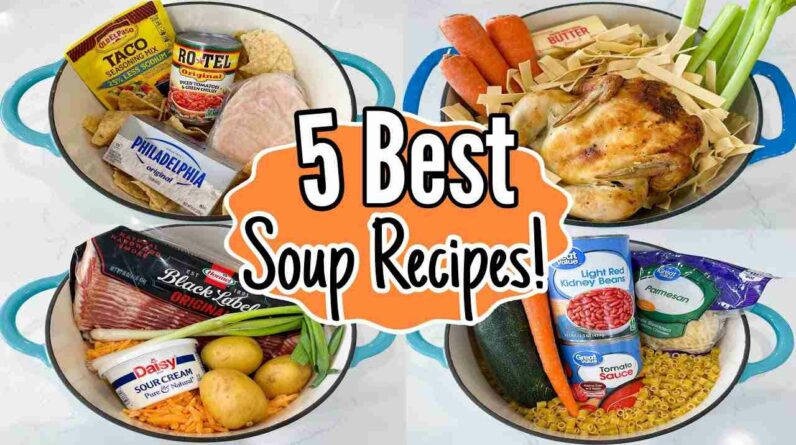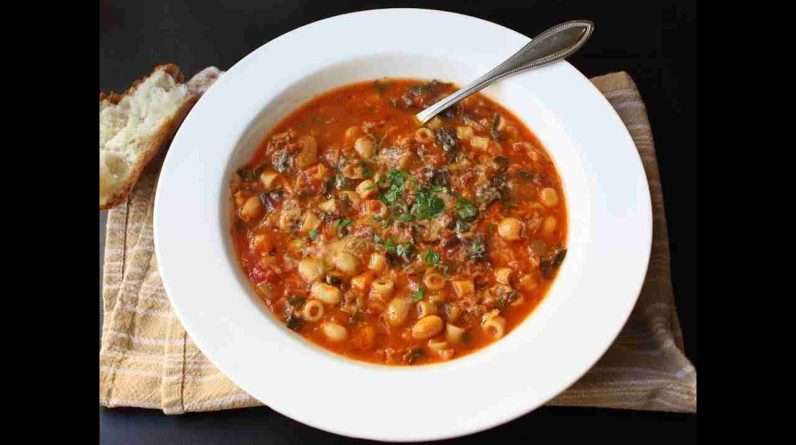Looking for an easy and delicious vegetable soup recipe? Look no further! This delightful dish is cozy, comforting, and requires minimal effort. You can customize it to your liking by choosing your favorite vegetables and adding extra ingredients like chickpeas, barley, or kale. The soup is seasoned with thyme, salt, and pepper, and cooked until the veggies are tender. It’s the perfect dish for those chilly days or when you need to use up ingredients in your fridge. Trust us, you won’t be disappointed with this beyond easy vegetable soup recipe!
Easy Vegetable Soup Recipe | Beyond Easy!
Vegetable soup is a cozy and comforting dish that is easy to make and perfect for those cold days when you want something warm and hearty. The best part is that it doesn’t require a ton of effort or ingredients. You can easily customize and make substitutions based on your personal preferences. Let’s dive into the ingredients and instructions for making this delicious soup!
Ingredients
Vegetables
- Onions
- Garlic
- Celery
- Carrots
- Potatoes
- Green beans
Additional ingredients
- Thyme
- Diced tomatoes
- Vegetable stock
- Corn
- Bay leaves
- Parsley
- Peas
Seasonings
- Salt
- Pepper
Instructions
Chopping the vegetables
Start by gathering all your vegetables and giving them a good rinse. Chop the onions into small bite-sized pieces. Peel and mince the garlic cloves. Chop the celery into fine pieces, taking into consideration any texture issues you might have with celery. Chop the carrots into beautiful little carrot moons, ensuring that they are not too thin to retain some texture in the soup. Finally, chop the potatoes into bite-sized pieces, ensuring that they are all roughly the same size.
Sautéing the vegetables
In a large pot or Dutch oven, heat three tablespoons of olive oil over medium-high heat. Once the oil is hot, add the chopped onions and sauté until they become translucent and begin to brown, stirring occasionally. This should take about 10 minutes. You can also add a smashed and chopped garlic during this time to infuse the oil with flavors.
Adding the remaining ingredients
After the onions have cooked for about 10 minutes, add the chopped carrots, celery, and garlic to the pot. Stir everything together and let it cook for about five minutes, stirring occasionally. This will allow the flavors to meld together and the vegetables to soften slightly.
Next, add diced tomatoes to the pot along with any herbs you want to include, such as thyme. Stir everything together and let it cook for about 10 minutes, stirring occasionally. This will help to cook down and concentrate the flavors of the tomatoes.
Seasoning and cooking
Add the chopped potatoes and green beans to the pot, along with frozen corn kernels and bay leaves. Stir everything together and season with salt and pepper to taste. Bring the soup to a boil, then reduce the heat to medium-low and partially cover the pot. Let the soup simmer until the potatoes are cooked through. The cooking time will vary depending on how thinly you sliced your potatoes, but it can take anywhere from 10 minutes to half an hour. Check the doneness of the potatoes with a fork.
Once the potatoes are cooked, add frozen peas and chopped parsley to the pot. Stir everything together and let the peas cook for a few more minutes until they are heated through and the parsley has wilted. Taste the soup and adjust the seasonings if needed.
Customization
Substitutions
One of the great things about vegetable soup is that you can easily customize it with substitutions based on your personal preferences or what you have on hand. For example, if you don’t have celery or don’t like the texture, you can omit it or substitute it with another vegetable like zucchini or bell peppers. Similarly, you can swap out the type of potatoes you use or add different vegetables like kale or chickpeas.
Optional additions
If you want to add more flavor and nutrients to your soup, there are plenty of optional additions you can consider. Some popular choices include barley, which adds a silky texture and filling quality to the soup. You can also add different herbs and spices, such as dill, parsley, or even curry powder to give the soup a unique twist.

Tips
Use fresh vegetables
For the best flavor and texture, it’s always recommended to use fresh vegetables in your soup. They will retain their nutrients and contribute to the overall taste of the dish. Avoid using canned vegetables, as they may have a different taste and texture.
Don’t overcook the soup
To ensure that your soup remains flavorful and the vegetables retain their texture, it’s important not to overcook it. Keep an eye on the soup while it’s simmering, and test the doneness of the vegetables with a fork to avoid mushiness.
Store leftovers properly
If you have leftover soup, it’s important to store it properly to ensure its freshness. Let the soup cool completely before transferring it to an airtight container and refrigerating. It will stay fresh for up to three to four days. If you want to extend the shelf life, you can also freeze the soup in individual portions and thaw it as needed.
Variations
Mexican vegetable soup
To give your vegetable soup a Mexican twist, you can add spices like cumin, chili powder, and paprika. You can also top it with avocado slices, crushed tortilla chips, and a dollop of sour cream for added creaminess.
Italian vegetable soup
For an Italian-inspired version, add Italian seasoning herbs like basil, oregano, and rosemary. You can also throw in some cooked pasta or gnocchi for a heartier meal.
Spicy vegetable soup
If you enjoy spicy flavors, you can add some heat to your vegetable soup by incorporating ingredients like chili peppers, jalapenos, or a dash of hot sauce. Adjust the spiciness to your preference.
Health Benefits
Nutrient-rich ingredients
Vegetable soup is packed with nutrient-rich ingredients like onions, garlic, carrots, and green beans. These vegetables provide essential vitamins, minerals, and antioxidants that support overall health and well-being.
High fiber content
The combination of vegetables and optional additions like barley or chickpeas makes vegetable soup high in fiber. Fiber is important for healthy digestion and can help you feel fuller for longer.
Serving Suggestions
Bread and butter
A classic serving suggestion for vegetable soup is a slice of crusty bread with a spread of butter. The warm soup pairs perfectly with the crunch of bread and the creamy richness of butter.
Crackers and cheese
Another accompaniment that pairs well with vegetable soup is a side of crackers and cheese. You can choose your favorite type of crackers and a flavorful cheese that complements the soup, such as cheddar or Gouda.
Grilled cheese sandwich
For a heartier meal, serve vegetable soup with a grilled cheese sandwich. The combination of the warm, comforting soup and the crispy, cheesy sandwich makes for a satisfying lunch or dinner.
Make-Ahead and Storage
Refrigerating
You can make vegetable soup ahead of time and refrigerate it for later use. Allow the soup to cool completely before transferring it to an airtight container and placing it in the refrigerator. It will stay fresh for up to three to four days.
Freezing
If you have a large batch of soup or want to save some for future meals, you can freeze it. Divide the soup into individual portions or store it in a large freezer-safe container. Make sure to leave some room for expansion. Frozen vegetable soup will stay fresh for up to three months.
Conclusion
Vegetable soup is a versatile and comforting dish that is easy to make and customizable based on personal preferences. With a variety of vegetables, seasonings, and optional additions, you can create a soup that is both delicious and nutritious. Whether you’re looking for a quick and easy meal or a way to use up ingredients in your fridge, vegetable soup is a go-to option. So gather your vegetables, chop them up, sauté them in a pot, and let the flavors meld together to create a warm and satisfying bowl of soup. Enjoy!









